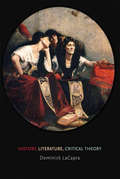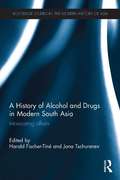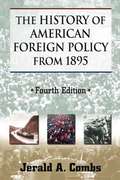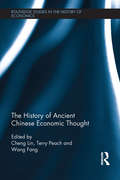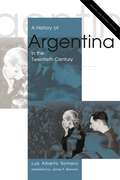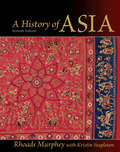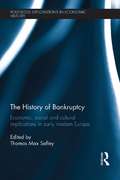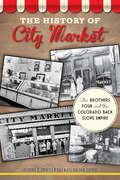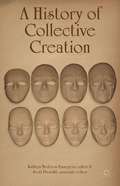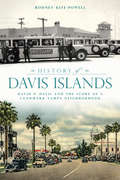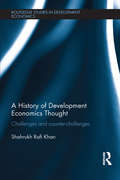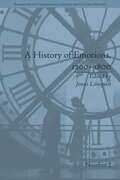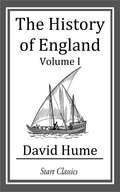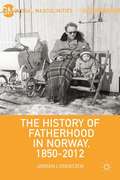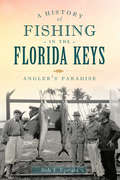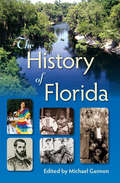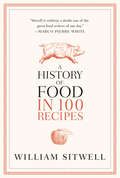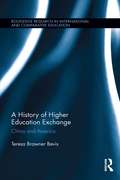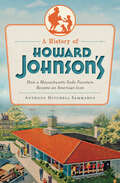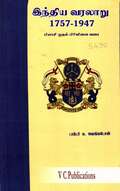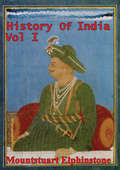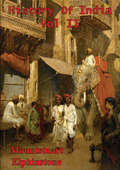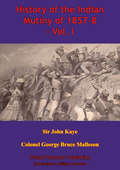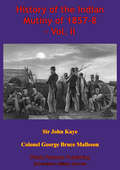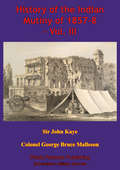- Table View
- List View
History, Literature, Critical Theory
by Dominick LacapraIn History, Literature, Critical Theory, Dominick LaCapra continues his exploration of the complex relations between history and literature, here considering history as both process and representation. A trio of chapters at the center of the volume concern the ways in which history and literature (particularly the novel) impact and question each other. In one of the chapters LaCapra revisits Gustave Flaubert, pairing him with Joseph Conrad. Other chapters pair J. M. Coetzee and W. G. Sebald, Jonathan Littell's novel, The Kindly Ones, and Saul Friedlander's two-volume, prizewinning history Nazi Germany and the Jews. A recurrent motif of the book is the role of the sacred, its problematic status in sacrifice, its virulent manifestation in social and political violence (notably the Nazi genocide), its role or transformations in literature and art, and its multivalent expressions in "postsecular" hopes, anxieties, and quests. LaCapra concludes the volume with an essay on the place of violence in the thought of Slavoj Zizek. In LaCapra's view Zizek's provocative thought "at times has uncanny echoes of earlier reflections on, or apologies for, political and seemingly regenerative, even sacralized violence."
A History of Alcohol and Drugs in Modern South Asia: Intoxicating Affairs (Routledge Studies in the Modern History of Asia)
by Harald Fischer-Tiné Jana TschurenevAt the beginning of the 21st century, alcoholism, transnational drug trafficking and drug addiction constitute major problems in various South Asian countries. The production, circulation and consumption of intoxicating substances created (and responded to) social upheavals in the region and had widespread economic, political and cultural repercussions on an international level. This book looks at the cultural, social, and economic history of intoxicants in South Asia, and analyses the role that alcohol and drugs have played in the region. The book explores the linkages between changing meanings of intoxicating substances, the making of and contestations over colonial and national regimes of regulation, economics, and practices and experiences of consumption. It shows the development of current meanings of intoxicants in South Asia – in terms of politics, cultural norms and identity formation – and the way in which the history of drugs and alcohol is enmeshed in the history of modern empires and nation states — even in a country in which a staunch teetotaller and active anti-drug crusader like Mohandas Gandhi is presented as the ‘father of the nation’. Primarily a historical analysis, the book also includes perspectives from Modern Indology and Cultural Anthropology and situates developments in South Asia in wider imperial and global contexts. It is of interest to scholars working on the social and cultural history of alcohol and drugs, South Asian Studies and Global History.
The History of American Foreign Policy from 1895 (xx xx)
by Jerald A CombsThis important text offers a clear, concise and affordable narrative and analytical history of American foreign policy since the Spanish-American War. The book narrates events and policies but goes further to emphasize the international setting and constraints within which American policy-makers had to operate, the domestic pressures on those policy-makers, and the ideologies, preferences, and personal idiosyncrasies of the leaders themselves.
The History of Ancient Chinese Economic Thought (Routledge Studies in the History of Economics #163)
by Cheng Lin Terry Peach Wang FangThis volume comprises twelve papers written by Chinese scholars on various aspects of the history of ancient Chinese economic thought. The contributions are preceded by an introduction which gives an overview of the development of the subject of history of economic thought in China, and which also provides an historical context to the individuals who constitute the major "schools" of ancient Chinese economic thought. The authors of the papers are leading scholars who have dominated this research area since the founding of New China in 1949, while the broad range of topics covered by the contributions includes questions of methodology, detailed and sometimes controversial interpretations of texts and "schools", and the international influence and modern relevance of ancient Chinese thought. A recurrent theme is that ancient Chinese thought has at least as much to offer to the historian as ancient Western thought. As the first such volume of papers to be translated into English, this collection provides a unique opportunity for non-Chinese readers to sample the way in which Chinese historians of economics have attempted to understand their own intellectual heritage. This book will be relevant to scholars interested in the history of economic thought, economic history and Chinese studies.
A History of Argentina in the Twentieth Century: Updated and Revised Edition
by James P. Brennan Luis Alberto RomeroA History of Argentina in the Twentieth Century, originally published in Buenos Aires in 1994, attained instant status as a classic. Written as an introductory text for university students and the general public, it is a profound reflection on the “Argentine dilemma” and the challenges that the country faces as it tries to rebuild democracy. Luis Alberto Romero brilliantly and painstakingly reconstructs and analyzes Argentina’s tortuous, often tragic modern history, from the “alluvial society” born of mass immigration, to the dramatic years of Juan and Eva Perón, to the recent period of military dictatorship. For this second English-language edition, Romero has written new chapters covering the Kirchner decade (2003–13), the upheavals surrounding the country’s 2001 default on its foreign debt, and the tumultuous years that followed as Argentina sought to reestablish a role in the global economy while securing democratic governance and social peace.
A History of Asia
by Rhoads MurpheyA History of Asia is the only text to cover the area known as "monsoon Asia" - India, China, Korea, Japan, and Southeast Asia--from the earliest times to the present. Written by leading scholar Rhoads Murphey, the book uses an engaging, lively tone to chronicle the complex political, social, intellectual, and economic histories of this area. Popular because of its scope and coverage, as well as its illustrations, maps, and many boxed primary sources, the new edition of A History of Asia continues as a leader in its field.
The History of Bankruptcy: Economic, Social and Cultural Implications in Early Modern Europe (Routledge Explorations in Economic History)
by Thomas Max SafleyThis volume takes up bankruptcy in early modern Europe, when its frequency made it not only an economic problem but a personal tragedy and a social evil. Using legal, business and personal records, the essays in this volume examine the impact of failure on business organizations and practices, capital formation and circulation, economic institutions and ethics, and human networks and relations in the so-called "transition" to modern society, from the early-sixteenth to the early-nineteenth century. One group of essays concentrates on the German-speaking world and shows a common concern for the microeconomics of bankruptcy, that is, for such issues as the structure of the firm, the nature of its capital, and the practices of its partners, especially their assessment of risk. Another group of essays shifts the focus from Central to Western and Northern Europe and away from the microeconomics of the early modern firm to an institutional consideration of bankruptcy. The final group of essays turns to Southern Europe, especially the Mediterranean basin, to assess bankruptcy not as an unfortunate result of crisis, but as an intentional response to crisis. All of the contributions are the result of original research; many of the scholars publish in English for the first time. All of the chapters are founded on close archival research, offering insights not only into business organization and practice but also into social and cultural aspects of economic life from the late sixteenth to the early nineteenth century.
History of City Market, The: The Brothers Four and the Colorado Back Slope Empire (Landmarks)
by Anthony F. Prinster Kate Ruland-ThorneCity Market's story begins with a penniless eighteen-year-old immigrant and closes with the business becoming part of the largest supermarket chain in the United States. In 1924, brothers Paul, Frank, Leo and Clarence Prinster bought a meat market in Grand Junction, Colorado, a business venture that would allow them to ride out the stock market crash and the Great Depression. It also allowed them to open the state's first supermarket in 1939, the beginning of an empire that remained in the family for over a century and helped shape the heritage of western Colorado. Tony Prinster shares how the City Market founders and its dedicated employees transformed a family business into the retail brand that touched the lives of so many people.
A History of Collective Creation
by Kathryn Mederos Syssoyeva Scott ProudfitCollective creation - the practice of collaboratively devising works of performance - rose to prominence not simply as a performance making method, but as an institutional model. By examining theatre practices in Europe and North America, this book explores collective creation's roots in the theatrical experiments of the early twentieth century.
History of Davis Islands: David P. Davis and the Story of a Landmark Tampa Neighborhood
by Rodney Kite-PowellTampa's Davis Islands has long been among the most desirable places to live on Florida's west coast. Created by David P. Davis during the 1920s Florida land boom, the project made him wildly rich and nationally famous. He followed up Davis Islands with a subdivision twice its size in St. Augustine, which he named Davis Shores. Davis sold his Tampa development in August 1926 but slipped into debt and died under mysterious circumstances while en route to Europe aboard a luxury liner in the early hours of October 13, 1926. Though he did not live to see it, work on Davis Islands continued, and the development ultimately became a huge success. Join author Rodney Kite-Powell as he examines the history of one of Florida's most famous neighborhoods.
A History of Development Economics Thought: Challenges and Counter-challenges (Routledge Studies in Development Economics #109)
by Shahrukh Rafi KhanThis book explores the history of economic development thought, with an emphasis on alternative approaches in macro development economics. Given that the pioneers of development economics in the 1940s and 1950s drew inspiration from classical political economists, this book opens with a review of key classical scholars who wrote about the progress of the wealth of nations. In reviewing the thinking of the pioneers and those that followed, both their theories of development and underdevelopment are discussed. Overall, the book charts the evolution of development economic thought from the early developmentalists and structuralists, through to the neo-Marxist approach and radical development theory, the neo-liberal counter revolution, and the debate between new developmentalists and neo-liberal scholars. It ends with an assessment of the state of the field today. This book will be of interest to all scholars and students interested in the evolution of development economics.
A History of Emotions, 1200–1800 (Studies for the International Society for Cultural History #2)
by Jonas LiliequistThe essays in this collection examine emotional responses to art and music, the role of emotions in contemporary notions of gender and sexuality and theoretical questions as to their use.
The History of England
by David HumeDavid Hume was a Scottish philosopher, economist, and historian. He is an important figure in Western philosophy, and in the history of the Scottish Enlightenment. Hume first gained recognition and respect as a historian, but academic interest in Hume's work has in recent years centered on his philosophical writing. His "History of England" was the standard work on English history for many years, until Macaulay's "The History of England from the Accession of James the Second". Hume was the first philosopher of the modern era to produce a naturalistic philosophy. This philosophy partly consisted in rejection of the historically prevalent conception of human minds as being miniature versions of the divine mind. This doctrine was associated with a trust in the powers of human reason and insight into reality, which possessed God's certification. Hume's scepticism came in his rejection of this 'insight ideal', and the (usually rationalistic) confidence derived from it that the world is as we represent it. Instead, the best we can do is to apply the strongest explanatory and empirical principles available to the investigation of human mental phenomena, issuing in a quasi-Newtonian project, Hume's 'Science of Man'. Hume was heavily influenced by empiricists John Locke and George Berkeley, along with various French-speaking writers such as Pierre Bayle, and various figures on the English-speaking intellectual landscape such as Isaac Newton, Samuel Clarke, Francis Hutcheson, and Joseph Butler.
The History of Fatherhood in Norway, 1850–2012 (Global Masculinities)
by Jørgen LorentzenThe first study of its kind, this book traces 150 years of the history of fatherhood in Scandinavia and shows how Scandinavian gender equality policy has important implications for the rest of the world. Among other interesting findings, Lorentzen reveals that the modern-day rise in equality fathering can be traced back to the 19th century.
A History of Fishing in the Florida Keys: Angler's Paradise (Sports)
by Bob T. EpsteinSince the arrival of Ponce de Leon in the 1500s, the Florida Keys have evolved from a dense, nearly impenetrable jungle full of bears, pumas, snakes, alligators and crocodiles into America's Caribbean islands. And the fish in the region have made the Keys one of the nation's favorite playgrounds for anglers. The Keys are home to more saltwater fishing records than any other angling destination in the world and offer sportsmen an array of amazing fish, from tarpon and Spanish mackerel to mahi-mahi and bonefish. U.S. presidents, celebrities and the world's greatest fishermen and women have cruised the waters of South Florida. Join author Bob T. Epstein on a journey through the storied history of fishing in the Florida Keys.
The History of Florida
by Michael GannonThis is the heralded “definitive history” of Florida. No other book so fully or accurately captures the highs and lows, the grandeur and the craziness, the horrors and the glories of the past 500 years in the Land of Sunshine. Twenty-three leading historians, assembled by renowned scholar Michael Gannon, offer a wealth of perspectives and expertise to create a comprehensive, balanced view of Florida’s sweeping story. The chapters cover such diverse topics as the maritime heritage of Florida, the exploits of the state’s first developers, the astounding population boom of the twentieth century, and the environmental changes that threaten the future of Florida’s beautiful wetlands. Celebrating Florida’s role at the center of important historical movements, from the earliest colonial interactions in North America to the nation’s social and political climate today, The History of Florida is an invaluable resource on the complex past of this dynamic state. Contributors: Charles W. Arnade | Canter Brown Jr. | Amy Turner Bushnell | David R. Colburn | William S. Coker | Amy Mitchell-Cook | Jack E. Davis | Robin F. A. Fabel | Michael Gannon | Thomas Graham | John H. Hann | Dr Della Scott-Ireton | Maxine D. Jones | Jane Landers | Eugene Lyon | John K. Mahon | Jerald T. Milanich | Raymond A. Mohl | Gary R. Mormino | Susan Richbourg Parker | George E. Pozzetta | Samuel Proctor | William W. Rogers | Daniel L. Schafer | Jerrell H. Shofner | Dr. Robert A. Taylor | Brent R. Weisman
A History of Food in 100 Recipes
by William SitwellA riveting narrative history of food as seen through 100 recipes, from ancient Egyptian bread to modernist cuisine.We all love to eat, and most people have a favorite ingredient or dish. But how many of us know where our much-loved recipes come from, who invented them, and how they were originally cooked? In A HISTORY OF FOOD IN 100 RECIPES, culinary expert and BBC television personality William Sitwell explores the fascinating history of cuisine from the first cookbook to the first cupcake, from the invention of the sandwich to the rise of food television. A book you can read straight through and also use in the kitchen, A HISTORY OF FOOD IN 100 RECIPES is a perfect gift for any food lover who has ever wondered about the origins of the methods and recipes we now take for granted.
A History of Higher Education Exchange: China and America (Routledge Research in International and Comparative Education)
by Teresa Brawner BevisWeakened by two Opium Wars and a succession of internal rebellions in the mid-1800s, China’s imperial leaders made a historic decision—to break a tradition of isolation and seek education outside the homeland’s borders. In time, an acquisition of science and technology from the rapidly-industrializing West would enable China to modernize its still-feudal economy and outdated military, thus restoring stability and establishing protection from future foreign encroachment. Today more than 200,000 Chinese are enrolled in colleges and universities across the United States, while the number of Americans choosing to study in China is rising. As we approach mid-century China is assuming a lofty position of world leadership. This book does not attempt to debate or determine the extent to which higher education exchange with the United States has impacted China’s rise . Instead it focuses on the story itself—of Sino-American education trade from its roots in antiquity to the present time—highlighting the people, programs, trials and triumphs that have wrought its extraordinary history. It will offer the first sequential, historically grounded book-length review of Sino-American education exchange that takes the story from its origins to the present day.
A History of Howard Johnson's: How a Massachusetts Soda Fountain Became an American Icon (American Palate Ser.)
by Anthony Mitchell SammarcoThe iconic restaurant chain that defined Americana by introducing twenty-eight flavors of ice cream, &“tendersweet&” clam strips, grilled &“frankforts,&” and more. Popularly known as the &“Father of the Franchise Industry,&” Howard Johnson delivered good food and fair prices—a winning combination that brought appreciative customers back for more. The attractive white Colonial Revival restaurants, with eye-catching porcelain tile roofs, illuminated cupolas, and sea blue shutters, were described in Reader&’s Digest in 1949 as the epitome of &“eating places that look like New England town meeting houses dressed up for Sunday.&” Learn how Johnson created an orange-roofed empire of ice cream stands and restaurants that stretched from Maine to Florida . . . then all the way across the country.
History of India (1757-1947) from Plassey to Partition: இந்தியாவின் வரலாறு (1757-1947) பிளாசி முதல் பிரிவினை வரை
by Dr Venkatesanஇந்நூலில் காலவரன்முறைக் கட்டுப்பாட்டுட்குட்பட்டு அறிவியல் கண்ணோட்டத்தோடு அணுகப்பட்டுள்ளது; அரசியல் நிகழ்வுகளோடு நின்றுவிடாமல் பொருளாதார, சமூக, சமய, வாழ்வியல் கலைகளுக்கும் சிறப்பிடம் அளிக்கப்பட்டுள்ளது; மேல்தட்டு மக்களின் வாழ்க்கையை விவரிப்பதோடு கீழ்தட்டு மக்களின் வாழ்க்கை விளைவுகளுக்கும் முக்கியத்துவம் கொடுக்கப்பட்டுள்ளது; சாதனையாளர்களின் வாழ்க்கைக் குறிப்புகள் அவர்களது ஆளுமை ஆற்றலைப் புரிந்து கொள்ளப் பயன்படும்.
History Of India Vol. I (History Of India #1)
by Mountstuart Elphinstone"Appointed through family influence to the East India Company, Mountstuart Elphinstone (1779-1859) arrived on the subcontinent in 1796, quickly learning Persian and developing an interest in Indian civilisation. After postings in Benares, Afghanistan and Poona, he became governor in 1819 of the recently acquired territory that became known as the Bombay Presidency, where he remained until his resignation in 1827. On his return to England, he devoted much of his time to writing and was a founder member of the Royal Geographical Society. This two-volume history, based on a range of Indian sources and first published in 1841, is infused with his lifelong understanding of Indian culture, science and philosophy. A scholarly refutation of James Mill's History, it was the most popular work of its kind among the early Victorian public. Volume 1 takes the history of the subcontinent up to the thirteenth century, while Volume 2 continues to the demise of the Mogul empire in the mid-eighteenth century."- Cambridge Library Collection
History Of India Vol. II (History Of India #2)
by Mountstuart Elphinstone"Appointed through family influence to the East India Company, Mountstuart Elphinstone (1779-1859) arrived on the subcontinent in 1796, quickly learning Persian and developing an interest in Indian civilisation. After postings in Benares, Afghanistan and Poona, he became governor in 1819 of the recently acquired territory that became known as the Bombay Presidency, where he remained until his resignation in 1827. On his return to England, he devoted much of his time to writing and was a founder member of the Royal Geographical Society. This two-volume history, based on a range of Indian sources and first published in 1841, is infused with his lifelong understanding of Indian culture, science and philosophy. A scholarly refutation of James Mill's History, it was the most popular work of its kind among the early Victorian public. Volume 1 takes the history of the subcontinent up to the thirteenth century, while Volume 2 continues to the demise of the Mogul empire in the mid-eighteenth century."- Cambridge Library Collection
History Of The Indian Mutiny Of 1857-8 – Vol. I [Illustrated Edition] (History Of The Indian Mutiny Of 1857-8 Ser. #1)
by Sir John William Kaye Colonel George Bruce Malleson[Illustrated with over one hundred maps, photos and portraits, of the battles of the Indian Mutiny]By 1857, British power in India had been largely undisputed for almost fifty years, however, the armies of the East India Company were largely recruited from the native people of India. This inherent weakness would be exposed during the events of the Indian Mutiny of 1857-1858, as the Sepoy soldiers turned against their erstwhile British employers.The events that led up to the Revolt were many and varied, including British highhandedness, ignorance of local customs and religious values, and incendiary propaganda. It is generally argued that the spark that lit the flame was the rumour that the newly issued rifle cartridges would be greased either with tallow, derived from beef and thereby offensive to Hindus, or lard, derived from pork and thereby offensive to Muslims. The enraged soldiers mutinied across a number of Indian States, taking Delhi, besieging Lucknow, and revolting in Oudh.The rebellion was eventually quelled in 1858 however, the effects of the Mutiny were far ranging and important. The East Indian Company was dissolved and the British government set about reorganising all facets of its power in India from the political to the administration and, most pointedly, the military. Although India would not gain its Independence until 150 years later, the events of the Indian Mutiny stayed in the folk consciousness of the country, a number of the leaders were lionized in certain circles, and a measure of nascent nationhood was born.Of the many books written on the event, few are as well respected, accurate, frequently read or cited as the six volume history produced by two ex-British Army officers, Sir John Kaye and Colonel George Malleson, who had both erved extensively in India. This first volume deals with the introductory causes and initial stages of the revolt to May 1857.
History Of The Indian Mutiny Of 1857-8 – Vol. II [Illustrated Edition] (History of the Indian Mutiny of 1857-8 #2)
by Sir John William Kaye Colonel George Bruce Malleson[Illustrated with over one hundred maps, photos and portraits, of the battles of the Indian Mutiny]By 1857, British power in India had been largely undisputed for almost fifty years, however, the armies of the East India Company were largely recruited from the native people of India. This inherent weakness would be exposed during the events of the Indian Mutiny of 1857-1858, as the Sepoy soldiers turned against their erstwhile British employers.The events that led up to the Revolt were many and varied, including British highhandedness, ignorance of local customs and religious values, and incendiary propaganda. It is generally argued that the spark that lit the flame was the rumour that the newly issued rifle cartridges would be greased either with tallow, derived from beef and thereby offensive to Hindus, or lard, derived from pork and thereby offensive to Muslims. The enraged soldiers mutinied across a number of Indian States, taking Delhi, besieging Lucknow, and revolting in Oudh.The rebellion was eventually quelled in 1858 however, the effects of the Mutiny were far ranging and important. The East Indian Company was dissolved and the British government set about reorganising all facets of its power in India from the political to the administration and, most pointedly, the military. Although India would not gain its Independence until 150 years later, the events of the Indian Mutiny stayed in the folk consciousness of the country, a number of the leaders were lionized in certain circles, and a measure of nascent nationhood was born.Of the many books written on the event, few are as well respected, accurate, frequently read or cited as the six volume history produced by two ex-British Army officers, Sir John Kaye and Colonel George Malleson, who had both erved extensively in India. This second volume deals events from May 1857 to July 1857.
History Of The Indian Mutiny Of 1857-8 – Vol. III [Illustrated Edition] (History of the Indian Mutiny of 1857-8 #3)
by Colonel George Bruce Malleson[Illustrated with over one hundred maps, photos and portraits, of the battles of the Indian Mutiny]By 1857, British power in India had been largely undisputed for almost fifty years, however, the armies of the East India Company were largely recruited from the native people of India. This inherent weakness would be exposed during the events of the Indian Mutiny of 1857-1858, as the Sepoy soldiers turned against their erstwhile British employers.The events that led up to the Revolt were many and varied, including British highhandedness, ignorance of local customs and religious values, and incendiary propaganda. It is generally argued that the spark that lit the flame was the rumour that the newly issued rifle cartridges would be greased either with tallow, derived from beef and thereby offensive to Hindus, or lard, derived from pork and thereby offensive to Muslims. The enraged soldiers mutinied across a number of Indian States, taking Delhi, besieging Lucknow, and revolting in Oudh.The rebellion was eventually quelled in 1858 however, the effects of the Mutiny were far ranging and important. The East Indian Company was dissolved and the British government set about reorganising all facets of its power in India from the political to the administration and, most pointedly, the military. Although India would not gain its Independence until 150 years later, the events of the Indian Mutiny stayed in the folk consciousness of the country, a number of the leaders were lionized in certain circles, and a measure of nascent nationhood was born.Of the many books written on the event, few are as well respected, accurate, frequently read or cited as the six volume history produced by two ex-British Army officers, Sir John Kaye and Colonel George Malleson, who had both erved extensively in India. This third volume deals with events from June 1857 to September 1857..
